A plant such as Campsis, also called begonia, is a deciduous woody vine that is directly related to the begonia family. This is a very large plant that loves warmth, decorated with large saturated color flowers. Campsis is translated from Greek as “bend, twist, bend”. There are gardeners who believe that kampsis and tekomaria (tekoma) are one and the same plant, but this is a mistake. Such plants are considered members of the same family, but they are related to different genera. This genus unites only a couple of species, while one of them has been grown in European parks since the 17th century.
Content
Features of Kampsis
This vine is often used for vertical gardening. The fact is that it is able to cling to and hold onto the support with its aerial roots. Unpaired complex leaf plates include from 7 to 11 leaves, which have a serrated edge. These leaves look very impressive. Tubular flowers are large and have no aroma at all. They are part of the short paniculate inflorescences located at the ends of the stems, while such flowers reach 9 centimeters in length, and their diameter is 5 centimeters. The color of the flowers depends on the variety and can be crimson, pink, orange-red or golden-red.
The plant begins to bloom in June and ends in September. This vine is considered a honey plant, and it is able to gather around itself not only bees, but also ants, wasps and flies. The fruit is a leathery, elongated pod that is 8 to 10 centimeters long. Such a pod consists of 2 valves, while inside it there are many membranous seeds with wings. The ripe fruit cracks, and many seeds fly out of it, which can fly far enough. But you should be aware that not all Kampsis have seeds. It is believed that for this it is necessary that a vine of another clone be in the immediate vicinity.
Planting Kampsis in open ground
Landing in the middle lane
In general, Kampsis is a fairly cold-resistant plant that can withstand a short-term drop in temperature to minus 20 degrees. However, planting such a liana directly into open soil in the middle lane is recommended only from mid-May. It is necessary to plant such a vine in the southern or southeastern part of the garden, while the selected area must be protected from drafts and strong winds. However, try to make sure that the campsis grows at a sufficient distance from the windows, the fact is that during flowering it attracts a huge number of insects. The composition of the soil can be absolutely any, it is grown even in an area with limestone soil, however, the soil should contain a large amount of minerals and trace elements. A planting hole for a plant should be prepared in the autumn, while its dimensions should be 40x50x50 centimeters.
How to plant
In the event that you want the vine to bloom at two or three years of age, plant it in open soil in this case, it is necessary to take a rooted cutting, which must be taken from a profusely flowering specimen.
When preparing the planting hole, you need to pull out the top layer of the earth and combine it with 0.5 kg of complete mineral fertilizer and 5 kg of compost. The resulting soil mixture should be poured onto the bottom of the pit. After that, the root system of the plant must be placed in the hole and straightened. Then you need to pour the soil mixture that remains into the hole in parts. The liana should not be buried; it should be planted at the same depth that it grew before. After planting, the surface of the trunk circle must be thoroughly tamped, and then the kampsis is watered. After the liquid is completely absorbed into the ground, it is necessary to sprinkle its surface with a layer of mulch (peat or compost). For such a plant, support is required, because it is a vine. After the support is dug in, the seedling is tied up. Remember that such a vine is quite aggressive, and so that it does not grow much, it is necessary to dig in slate or metal sheets around the trunk circle, while they must be buried approximately 0.8 meters.
Growing Kampsis in the garden
Do not be afraid that this plant is exotic. The fact is that it is relatively unpretentious and not too demanding to care for. It is necessary to care for such a vine in almost the same way as for the rest of the plants. It should be watered in a timely manner, the topsoil should be loosened, weeded and fed on time. You should also protect the plant from harmful insects and diseases, and be sure to prune on time. Particular attention should be paid to watering such a plant, because it reacts extremely negatively to both stagnant liquid in the root system and drought. Remember that while the soil is wet, removing all weeds and loosen the top layer will be much easier. Despite the fact that the plant is quite resistant to drought, it should be watered in a timely manner, because otherwise its decorative effect will significantly decrease. In order to reduce the number of watering, it is recommended to plant several compact low-growing shrubs on the section of the near-stem circle, while the rules of care for all these plants, including the liana, must be the same.
Campsis need not be fed. However, if you apply a fertilizer containing phosphorus and nitrogen to the soil, then it will bloom very luxuriantly throughout the season.
Pruning
Such a plant needs systematic pruning. The formation of a bush should be started after planting. To do this, you need to cut off all the stems so that the remaining segment is 15 centimeters. After the shoots begin to grow, you should choose 4 or 5 of the most powerful, and cut off all the rest.As the stems grow, they need to be guided along the support, and if the need arises, it will be possible to tie the shoot to it. Liana will be considered formed only when the length of the skeletal branches is equal to 400 centimeters. And this will happen after about 2 or 3 years. Lateral stems must be cut off every year to two or three eyes, while weakened, dried, affected by disease, as well as growing in the wrong direction, must be cut off. If any of the skeletal branches was severely injured, then it must be cut off completely. After a while, replacing branches will appear in its place, from which it will be necessary to select one of the most powerful, while the remaining ones need to be cut off. If necessary, you can do anti-aging pruning, for this you need to cut off all branches at a height of 0.3 meters. The pruning procedure is recommended in early spring, when the buds are still sleeping.
During flowering, you need to promptly cut off the flowers that have begun to fade, as well as cut off those branches that have bloomed by 3 or 4 eyes. In this case, the plant will bloom for a very long time and look very impressive.
Why flowers don't appear on Kampsis
Often, gardeners cannot wait for the flowering of Kampsis, which was grown from seed. The fact is that in this case, the vine will be able to bloom for the first time only 4–6 years after the seedling appears. If you grow such a vine from a cuttings, then it will bloom in the third year. Also, late frosts in spring, harmful insects or diseases, as well as a draft can become the cause of this phenomenon. If you grow such a vine in a region with a relatively cold climate, then you can not wait for its flowering either.
Harmful insects and diseases
This plant is highly resistant to diseases and harmful insects. However, if water stagnates in the roots, then rot may appear on them, and aphids can settle on the liana during a dry, sultry period. To destroy aphids, the specimen should be treated with a solution of tar soap (10 grams of substance per bucket of water).
Reproduction of Kampsis
For reproduction of such a plant, seeds, layers, root shoots, as well as lignified or green cuttings are used.
Growing from seeds
This method of reproduction of Kampsis, as generative (seed), has 2 major drawbacks. The first drawback is that the vines grown in this way are only rarely able to inherit the characteristics of the parent plant, and the second - such a kampsis begins to bloom several years later than the one that was grown vegetatively. The advantage of this method is that it is the simplest. Seeds do not need to be stratified or prepared in any special way before sowing, and they can also be stored at room temperature. Sowing of seeds is carried out in spring, while using a water-permeable neutral substrate. You need to bury the seeds in the soil only half a centimeter, then the container is removed to a warm place (25 degrees). The first seedlings will appear after 4 weeks. After the seedlings have 3 pairs of true leaves, they will need to be planted in open ground in a permanent place.
Cuttings
Green cuttings should be prepared in June or July, with only the middle part of the stem taken. All leaves should be removed from them except the top 2-3, which will need to be shortened by 2/3. It is necessary to make a bed in a shaded place and plant a cutting there at an angle of 45 degrees. It should be borne in mind that the soil must be loose and fertile. The planted cuttings need to be watered, and the surface of the bed should be covered with a layer of mulch. On average, every ninth stalk out of 10 is rooted.
You can also use a lignified stalk for reproduction. They should be prepared at the beginning of the spring period, while lignified one-year-old shoots should be used.Cuttings are planted at an angle to a permanent place, because on average 10 cuttings out of 10 are rooted.
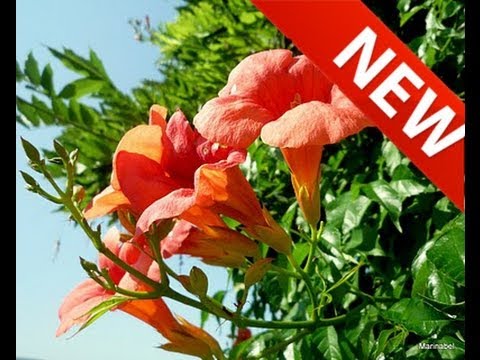

Watch this video on YouTube
How to propagate by root shoots
If the conditions for growing such a vine are favorable, then it will have a dense root growth. Dig up the root process with part of the root, and then plant it in a place where it will grow constantly. This procedure should be performed in early spring or after all the leaves have fallen off.
Reproduction by layering
In springtime, you should choose the stem that grows near the surface of the soil. It is bent to the ground and fixed in this position. During the growing season, it is necessary to ensure that the soil around the layer is constantly loose and moist. With the onset of the next spring period, the rooted cuttings are separated and planted in a permanent place. Such a plant has a fairly rapid growth and development.
After flowering
This liana is quite frost-resistant. So, she can safely tolerate a drop in temperature to minus 20 degrees, but it should be short-lived. If the winter is long and frosty, then the plant will need shelter. In this regard, experts advise making removable supports for Kampsis, so that they can be removed in autumn, and re-installed with the onset of spring. Such a plant is covered for wintering in almost the same way as grapes. The stems must be removed from the support and placed on the ground surface. Then they must be covered with a layer of dried foliage, sawdust or spruce branches. On this layer it is necessary to lay a film, which is again covered with spruce branches.
Types and varieties of Kampsis with photos and names
This genus is represented by only two species. The homeland of the large-flowered campsis is China and Japan, and the rooting campsis is North America. Thanks to the work of breeders, a third species of Kampsis, called hybrid, was born.
Rooting campsis (Campsis radicans), or bignonia rooting (Bignonia radicans)
This vine can reach a height of 15 meters, while in order to cling to the support, it uses many air roots. Unpaired leaf plates reach 20 centimeters in length, they include from 9 to 11 leaves. The front side of the leaves is naked and painted in a deep green color, and the back side is pale green, and on its surface there is pubescence, which can be located throughout the entire leaf plate or only on the veins. The funnel-shaped tubular flowers are about 9 centimeters long, and their diameter is 5 centimeters. The corolla is deep orange, and the limb is fiery red. The apical racemose inflorescences contain from 10 to 15 flowers. The flowering of this liana is quite long due to the fact that the opening of flowers occurs gradually. And this species begins to bloom in the second half of the summer period. The fruits are pod-shaped flat capsules, the length of which is 5–12 centimeters. Cultivated since 1640. Decorative forms:
- Magnificent. Such a plant is weakly climbing. Outwardly, it looks like a shrub with thin and long stems. The complex leaf plates include small oval-shaped leaves. The flowers are orange-red.
- Golden. The flowers are yellow.
- Early. Large flowers are colored scarlet. Flowering begins 4 weeks earlier than the base species.
- Dark purple. Large dark scarlet flowers have a purple tint.
Large-flowered campsis (Campsis grandiflora), or Chinese campsis, or Chinese bignonia (Bignonia grandiflora)
It does not have air roots like the previous species. Such a liana clings to the support with the ends of the stems. This plant has a relatively low height, and most often is more similar to a short shrub. The composition of pinnate leaf plates includes from 7 to 9 leaflets, having a length of about 6 centimeters.There is no pubescence on their seamy surface. Orange-red funnel-shaped tubular flowers are large in comparison with the previous species, so they can reach 8 centimeters in diameter. From the moment the seedling appears, and until the first flowering, 3 years pass. The fruit is a pod-shaped capsule, reaching a length of 15 to 20 centimeters. This species is less hardy than the previous one, but it is much more beautiful. The species has a decorative form - the Thunberg campis. Its orange flowers have a short tube and the same lobes. Cultivated since 1800
Campsis hybrid (Campsis x hybrida)
As a rule, this species is a shrub with a spreading crown. Less often, it looks like a climbing plant. Its complex leaf plates include from 7 to 11 leaves. The size and color of flowers is similar to large-flowered Kampsis. Differs in a relatively high frost resistance, like rooting kampsis. Cultivated since 1883.

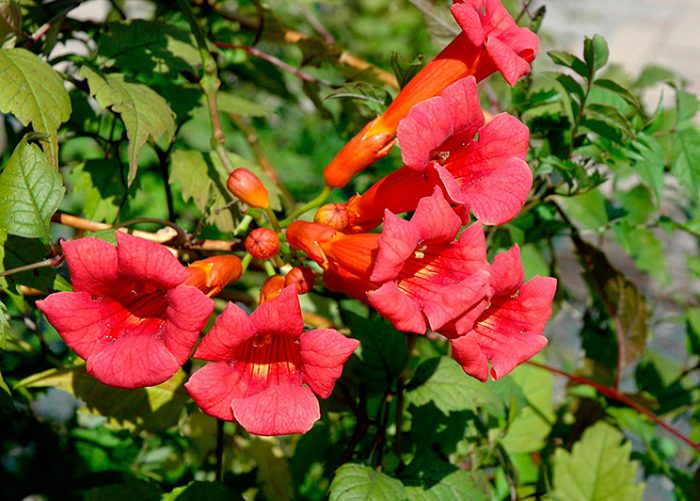
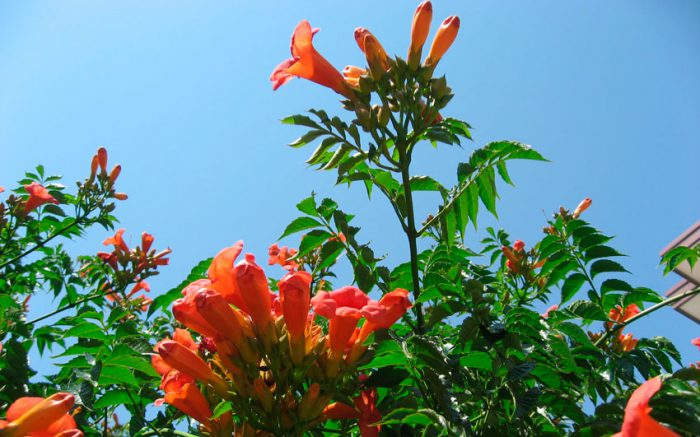


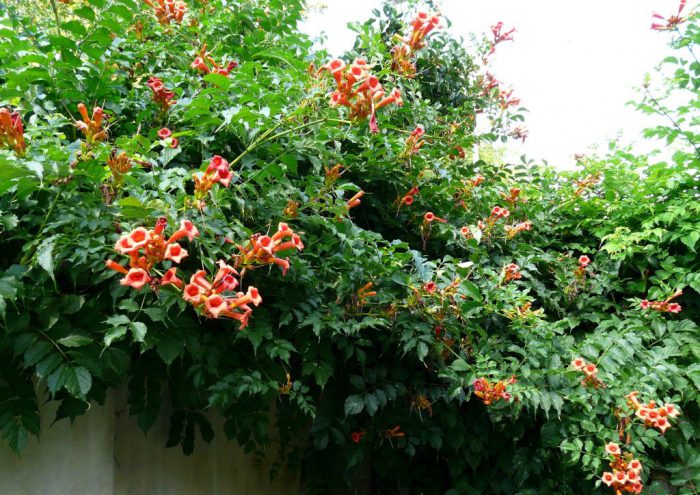


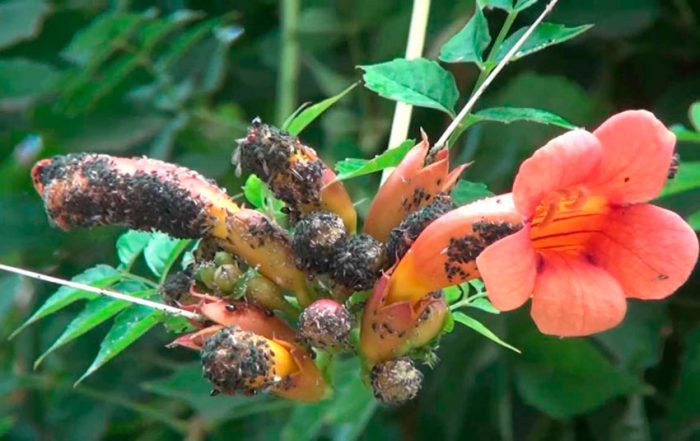
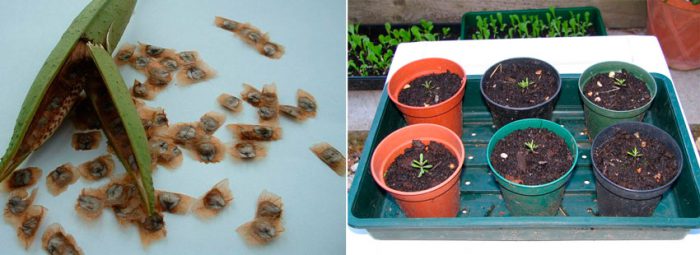


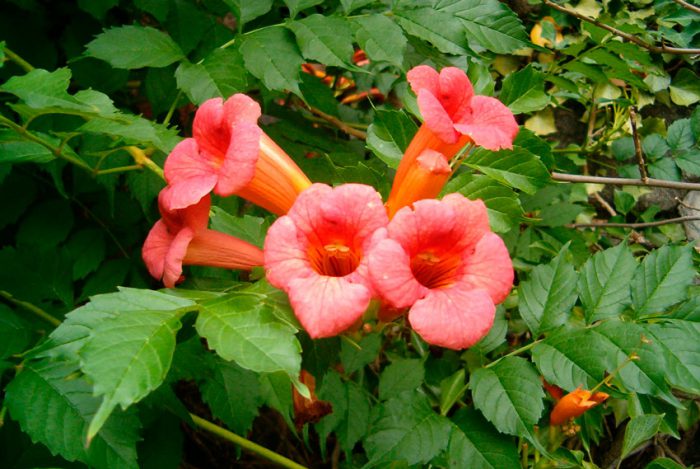
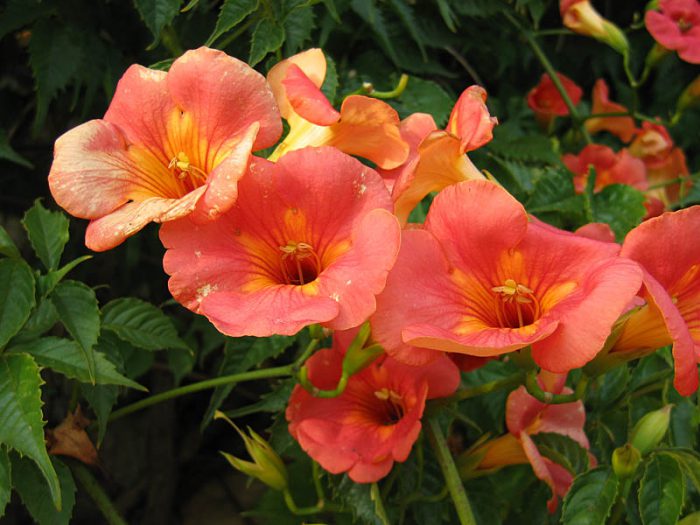
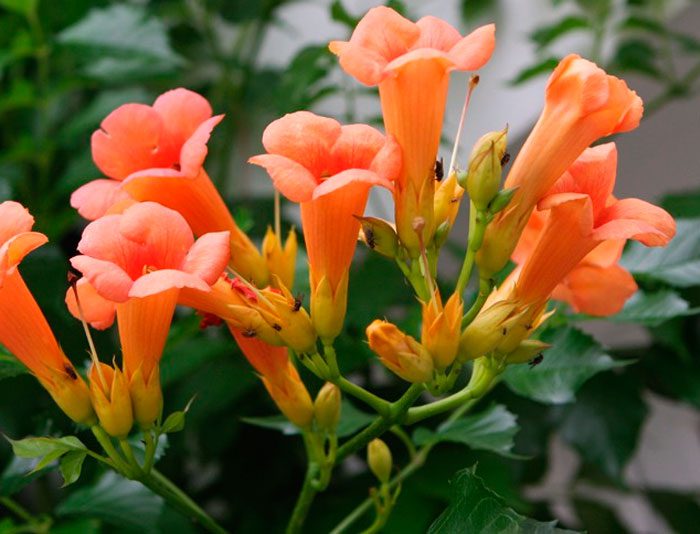
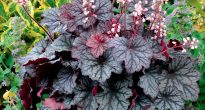



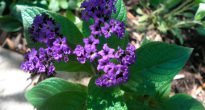





taking root
is it a mistake or a species name?
Name
Campsis is from the bignoniaceae family, not from begoniaceae. These are different families